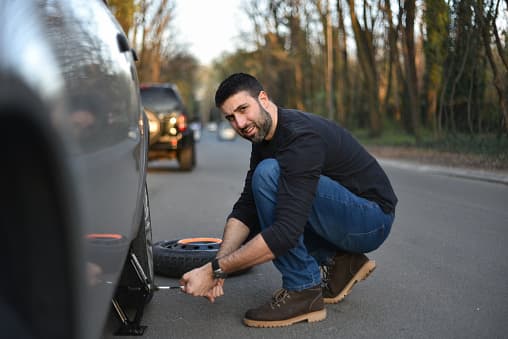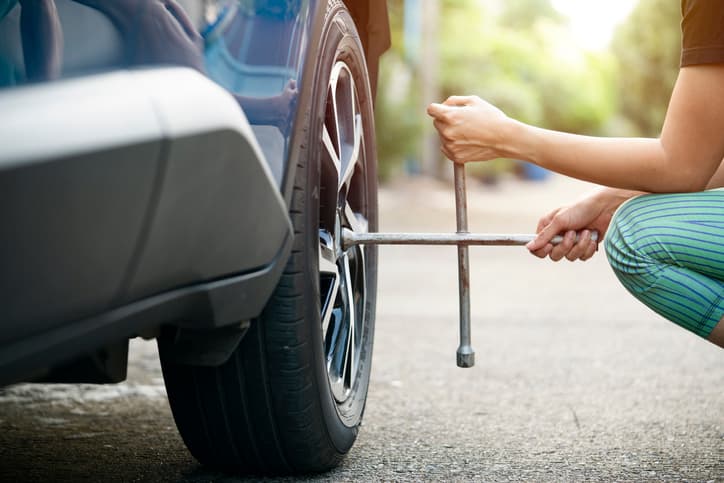Driving On A Spare Tyre
Safety when driving on a spare tyre

There’s plenty you need to know when it comes to spare tyres, and we’ve got all the information right here.
If you get a puncture or other tyre problem while driving, your spare tyre can come to the rescue. Most experts argue that you should travel no more than 80km on a spare tyre, but if you have to, there are some tips you can follow to make sure you are driving as safely as possible.
What Kind Of Spare Tyre Do You Have?
There are a few crucial things to consider once you’ve replaced a damaged tyre with a spare. The most important is what type of spare you have in the boot. In some cases, you may not have a spare tyre at all. Some car manufacturers only provide a repair kit, with tyre sealant and inflator.
If it’s a full-size spare tyre, it can stay on longer provided it is in good condition. Some spares may not be, as they’ll be quite old and not checked as regularly as your active tyres. However, it’s usually a good idea to head to a garage or repair centre if you’ve had a puncture or blowout. You can get the damage checked out and potentially repaired, so you can then replace the tyre and/or the spare. Even if your spare tyre is in good condition and a match for your other tyres, you’ll still need to ensure you have a fully functioning spare tyre in the boot.
In many new cars, the spare tyre will be quite different. To save room in the boot, manufacturers will issue new cars with skinny or ‘space saving’ tyres. These are smaller and much narrower than your other tyres, and are only ever meant as a temporary solution. You should get the spare replaced with a full size matching tyre, and drive slowly and carefully until you reach a mechanic or repair centre.
You can’t leave a temporary spare tyre on the car permanently. If your tyres don’t match or an unsuitable tyre is in use, your vehicle could fail its NCT. Driving on a temporary tyre could even invalidate your car insurance.
The NCT test is particularly tough on tyres, especially since the main cause of NCT failures in 2018 was revealed to be bad tyres. Common problems included mismatching tyres on the same axle, as well as cars using a mix of summer and winter tyres, or tyres with different speed ratings. Even older tyres (for example, older than six years) will trigger a ‘pass advisory’ note when spotted.
To ensure your car passes its NCT, you’ll need to look after your tyres properly. Check them regularly and have any issues - with the active tyres and the spare - checked out as soon as possible. After all, you don’t want to leave it until you’ve broken down on the motorway to discover that your spare tyre isn’t fit for use.
How Fast Can You Go On A Spare Tyre?
If you have a full size matching tyre, you can drive up to the speed limit as usual, but be careful if your spare tyre is old or you aren’t sure of the condition. You may also want to slow down if you suspect there’s been any damage to the wheel itself - which can happen when driving over particularly nasty potholes, hitting kerbs or any other collisions.
If you’re driving on the much smaller space-saving tyre, it’s crucial to limit your speed to no more than 80 km/h (50mph). Before setting off, check the maximum recommended speed limit set by the tyre’s manufacturer. There may also be restrictions on where on the car you can use a space-saving spare - for example, ‘front only’ or ‘back only’.
Even if you’re worried about annoying other motorists, it’s important to drive slowly and carefully when a spare tyre is fitted. After all, if anything happens to the spare tyre, you’ll be out of options and will need to call your breakdown service for rescue. Bear in mind that the handling of the car will feel different once the skinny spare tyre is fitted. This is another reason to go slow and steady until you reach a repair centre.
Can You Use A Spare Tyre More Than Once?
Space saver tyres may be temporary options, but they can really help you out in a fix. And the good news is that they can be used more than once, provided the tyre is still in a roadworthy condition. The same also goes for full-size matching spare tyres.
To get the best use of your spare tyre, aim to get the original tyre repaired and back on the car as soon as you can. Your spare can go back in the boot, just in case you ever need it again.
However, it’s important to give your spare tyre regular checks, just like your other tyres. Each time the temporary spare is used, the tread will wear down slightly. At some point, the tread wear indicators will show that it no longer offers enough grip on the road and needs replacing.
You should also aim to check that the spare tyre is properly inflated. Keeping an inflator kit in the boot is also a good idea, so you can top up the air if needed before using the spare.
What To Do If You Get A Flat Tyre
Getting a flat tyre or puncture while driving can be alarming. You may notice a change in handling of the car, or an unnerving noise of the flat tyre on the road surface. If this happens, it’s important to stay calm and safely pull over as soon as possible. Breakdowns aren’t ideal, but they don’t have to turn into a nightmare.

If you know how to change a tyre and it’s safe to do so, you can get the spare tyre out of the boot and fit it. Otherwise, you’ll need to call your breakdown assistance service. Find somewhere safe and away from traffic to wait, until the technician arrives to change the tyre.
Make sure you follow all advice you’re given, such as driving at a minimum speed on a narrow, temporary spare tyre. As soon as you can, head to a garage to get your tyre looked at.
When Should I Change My Tyres?
Your car’s tyres are one of the most important components of your vehicle and should be inspected regularly, to prevent any damage or possible breakdowns. Below we take a look at some of the reasons why you should regularly inspect your tyres and why it may be time to change them.
An Aging Tyre
There is no set lifespan for your car’s tyres. There are cases where a tyre may last less than a year due to an unfortunate event. However, typically after 5 years of service, your tyres should be inspected annually to see if they need to be replaced. If your tyres are older than 10 years, we recommend replacing them with new tyres.
Damaged Goods
Due to the speed a car can travel, your tyres are prone to damage, especially if they have any impact on a curb, pothole or any objects that may be on the roads. We recommend personally inspecting your tyres on a regular basis and in particular if you have just undertaken a long journey. It is also worth noting that checking the tyre pressure regularly can prevent any further damage to your tyres and car.
It’s The Law
One of the main reasons for you to carry out regular tyre checks is to ensure that the tread is of the legal limit. The legal requirement for your tyre tread is 1.6mm and if your tyre's tread is near this we recommend replacing your tyres, especially for any long journeys you may take, as there is a possibility of a tyre blowout.
Fuel Efficiency
As seen in our blog on fuel efficiency, if your tyres are worn down or low on air, this can result in your car being less fuel efficient and could leave you out of pocket. It's important to regularly check your tyres for this very reason, so you can not only save money on petrol but also on any car repairs or damages as a result of having old or worn tyres.
Our final tip is to make sure you and your car are protected in case of an unfortunate event. We offer a range of great value car insurance policies which may suit your needs. Give us a call on 01 4003400 or get a quote above.
